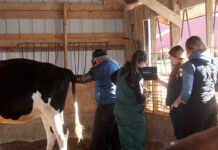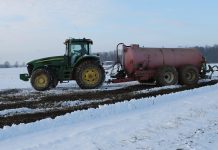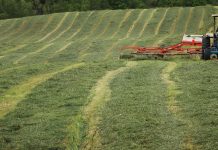We were inches away from an entirely different set of crop and feed prices. Inches of rain that is. During the Ag Outlook Meetings early this year, back when we thought grain and feed prices were high — and feed purchasers would appreciate being back at or below those price levels no — the prediction was that if most of the country had good weather and good yields, we could easily be back to $4, if not $3, corn. Didn’t happen.
With widespread drought impacting yields, and consequently markets, standing crops are potentially worth big bucks.
If a previously unpriced corn crop yielding 120 bushels per acre actually receives $7 per bushel at the elevator after all quality discounts, it will net the same $200-plus dollars per acre that a normal yield of 192 bushels per acre would have at the $5.50 per bushel the OSU Corn Budget projected at the beginning of the growing season.
If we would have had a good crop and corn price dropped into the $5 range, yields in the 120 bu range start to lose money and at $4.25 per bushel, all yield levels from 120 to 200 bushels per acre have negative returns over total costs per acre.
The point
So, what is the point? It is relatively easy to make money when prices are high. But as quickly as they are high, they can be low again.
Dairy farmers are all too familiar with this scenario as they deal with it on a month-to-month basis. Crop growers have had a couple years of higher prices to build equity in their operations. Dairy farmers that grow crops have had an opportunity to positively impact their cost of production if they do a good job producing crops.
But what happens when we hit $4.25 corn again? Do you want to be in the group of farms that loses money growing corn with costs at budget or above? Or do you want to be in the group of farms that makes money with costs below the projected budget costs?
Personally, I would rather be in the group that makes money. The biggest challenge I see for many Ohio growers, both dairy and crop oriented, is the lack of control over costs.
Not saying that they don’t shop around for prices as best they can, but they don’t really know what their costs are or have been on an individual crop basis. How do you effectively manage what you don’t know?
Seed cost
Take seed cost for instance. If corn, corn silage, alfalfa, wheat and soybeans are grown in a farm’s rotation, we can usually find total seed costs in the farm’s records. But sometimes it is very difficult to determine how much each crop’s share of that total seed cost was, especially when seed is prepaid in one year for use in the next if type of seed was not recorded.
Long term, tweaking the record-keeping system to allocate individual crop expenses to crop type at the time bills are paid should be done. A quick and simple fix! In the short term, reviewing invoices for this information may be the only option. The seed consultant may be able to provide this information, but frankly I haven’t been real impressed with the some of the paperwork I’ve seen from some companies.
So why bring this up when standing crops will obviously make money this year? Because we were inches away from a completely different scenario. Dairy farms that grow much of their own feed and had a decent crop will be in good shape this year. Dairy farms that are buying feed will not. Many crop farms and dairy farms that grow crops will be challenged when corn prices drop back to $4.25 if input prices do not also drop — how likely is that?
Now is the time to fine-tune data collection to calculate your crops’ cost of production. To do it as painlessly as possible, take a few minutes now to record yields, income, and costs while they are fresh and easier to find than 5 months from now.
Farm summary
This fall we will be releasing the Ohio Farm Business Summary for 2011 and 2010. It will include crop enterprise analyses along with dairy enterprise analysis for participating Ohio farms. How do the best look? What does average look like for Ohio? How would your farm stack up?
The opportunity to participate in the 2012 summary will be available again for dairy, crop and livestock farms. Gather important crop production information now, while it is happening, and enterprising the crops will be immensely easier.
After harvest is complete, contact your OSU Agriculture Extension educator or myself about conducting an analysis for your farm business for 2012. Be sure that you will be in the group that makes it at $4.50 corn.












